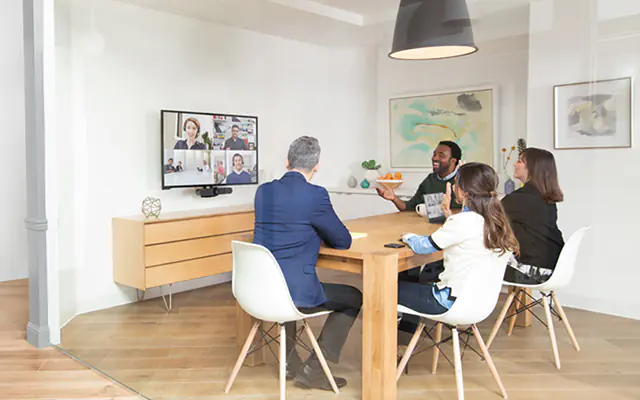Some of our top design tips if you are upgrading a huddle room or planning a new one
With the emergence of this effective collaboration solution, small teams no longer need to set up the entire boardroom for short discussions. While its capabilities can significantly increase efficiencies, poor huddle room design can dilute the potential impact on team productivity.
Here are a few design tips for huddle rooms offering space-specific solutions:
- Present content wirelessly – Wireless content sharing is probably the most popular and impactful design feature for a modern huddle room. The room display can receive wireless content from any user laptop or mobile device. This can be enabled by a wide range of wireless presentation devices. Proper placement of the device to ensure smooth connectivity for presenters is important. Devices that can allow multiple simultaneous connections are preferable since this minimizes the transition time between presenters.
- Invest in both Audio and Video conferencing – Most organizations are beginning to invest in video conferencing as a tool for smoother and more natural interactions between remote teams. However, audio conferencing should not be neglected either as it provides a lower-cost option for collaboration when bandwidth availability is low or hampered due to connectivity loss. Rooms equipped with both provide users with the flexibility to choose according to the nature of the meeting that they are participating in and lead to savings for the organization. Another often underestimated aspect is the impact of audio on video conferencing quality itself. A great video doesn’t work well without great audio, and appropriate sound treatment or a program audio system can help considerably in improving the experience.

- Use Minimal and functional furniture – As teams of various sizes are expected to utilize huddle rooms for different types of interactions, it makes sense to have minimal furniture. It should be mobile enough to be moved around depending on the requirements. Seating for 4-5 people is common but it is a good idea to choose or create furniture with additional functionality like integrated cable cubbies for a clutter-free environment. Wireless presentation technology can help simplify this even further.
- Opt for Software codecs or Cloud VC for video conferencing – Growing businesses need growing solutions with a high return on investment. As more teams need to collaborate remotely, the cost of traditional hardware-based VC codecs becomes a limitation. Many organizations can, therefore, opt for a laptop-based or a soft Video Conferencing solution. It costs much less and lets participants to just walk in with their laptops, connect and present to remote locations. Adopting a Cloud VC solution can bring further benefits of simpler manageability and lower costs. Services like Webex, Skype for Business, Zoom, Bluejeans can power huddle rooms, and bring in other useful features like recording and streaming of meeting video to make video collaboration even easier to use.
- Optimise Room Acoustics and Lighting –While significant investments are made in the AV equipment for huddle rooms, factors like acoustics and lighting often get overlooked. Both of these can have a significant impact on VC quality and are therefore worthy of closer consideration. This includes aspects like audio treatment to improve audibility and sound insulation to ensure privacy and eliminate external noise. A professional-quality microphone setup can remarkably increase the audio quality too. Similarly, the room lighting deserves attention, with care to ensure sufficient illumination on the face of participants without creating a glare that lowers quality for remote users.
- Add interactivity with Annotation capabilities –Even though new collaboration tools allow us to present information in new ways, there continues to be value in older ways of presenting like the use of whiteboards. New generation touch-interactive displays allow people to create drawings and annotate content. These “notes” can be captured and shared digitally which increases their utility to the presenter. Conventional flat displays can also be equipped for this by adding a screen overlay and loading software onto the presentation computer.
FAQ’s
Smart lighting is an easy and cost-effective entry point that enhances convenience through remote control, automation, and voice commands, setting the foundation for more complex smart home setups later.
Automation scenes let multiple smart devices work together triggered by time, actions, or conditions—for example, setting a “Goodnight” routine that turns off lights and locks doors automatically—boosting convenience and efficiency.
Starting with a few essential devices like smart lights and sockets or perhaps limiting implementation to a single room can help users get comfortable with smart tech before expanding. This phased approach reduces complexity, spreads cost, and ensures each addition suits user needs.
If you are already familiar with smart lighting and control systems however, and have a good sense of what you want in terms of the experience – going for a full system may be much more satisfying.
Secure your network with strong passwords, regularly update device firmware, configure access controls, and choose reputable brands that follow industry security standards to safeguard your smart home from unauthorized access.


